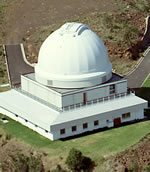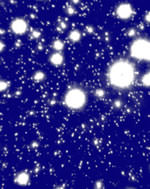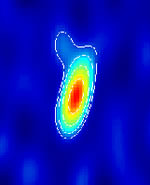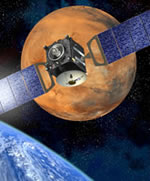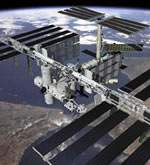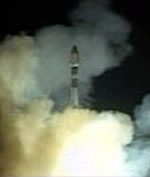
Image credit: ESA
After a picture perfect launch Monday afternoon, the European Space Agency’s Mars Express is now headed towards the Red Planet. The spacecraft, attached to the top of a 4-stage Russian Soyuz-Fregat rocket, lifted off from the Baikonur cosmodrome at 1745 GMT. Over the course of the next 90 minutes, the rocket shed each one of its four stages during an orbit around the Earth and then hurled the Mars Express into its planned trajectory. Mars Express communicated back with European Space Operations at 1944 GMT. The probe’s solar arrays had deployed properly, its batteries are working, and the spacecraft seems to be working normally. It will reach Mars in another six months.
The European Mars Express space probe has been placed successfully in a trajectory that will take it beyond the terrestrial environment and on the way to Mars ? getting there in late December.
This first European Space Agency probe to head for another planet will enter an orbit around Mars, from where it will perform detailed studies of the planet?s surface, its subsurface structures and its atmosphere. It will also deploy Beagle 2, a small autonomous station which will land on the planet, studying its surface and looking for possible signs of life, past or present.
The probe, weighing in at 1 120 kg, was built on ESA?s behalf by a European team led by Astrium. It set out on its journey to Mars aboard a Soyuz-Fregat launcher, under Starsem operational management. The launcher lifted off from Ba?konur in Kazakhstan on 2 June at 23.45 local time (17:45 GMT). An interim orbit around the Earth was reached following a first firing of the Fregat upper stage. One hour thirty-two minutes after lift off, the probe was injected into its interplanetary orbit.
“Europe is on its way to Mars to stake its claim in the most detailed and complete exploration ever done of the Red Planet. We can be very proud of this and of the speed with which have achieved this goal”, said David Southwood, ESA’s Director of Science witnessing the launch from Baikonur. Contact with Mars Express has been established by ESOC, ESA?s satellite control centre, located in Darmstadt, Germany.
The probe is pointing correctly towards the Sun and has deployed its solar panels. All on-board systems are operating faultlessly. Two days from now, the probe will perform a corrective man?uvre that will place it in a Mars-bound trajectory, while the Fregat stage, trailing behind, will vanish into space ? there will be no risk of it crashing into and contaminating the Red Planet.
Mars Express will then travel away from Earth at a speed exceeding 30 km/s (3 km/s in relation to the Earth), on a six-month and 400 million kilometre journey through the solar system. Once all payload operations have been checked out, the probe will be largely deactivated. During this period, the spacecraft will contact Earth only once a day. Mid-journey correction of its trajectory is scheduled for September.
There in time for Christmas
Following reactivation of its systems at the end of November, Mars Express will get ready to release Beagle 2. The 60 kg capsule containing the tiny lander does not incorporate its own propulsion and steering system and will be released into a collision trajectory with Mars, on 20 December. It will enter the Martian atmosphere on Christmas day, after five days? ballistic flight.
As it descends, the lander will be protected in the first instance by a heat-shield; two parachutes will then open to provide further deceleration. With its weight down to 30 kg at most, it will land in an equatorial region known as Isidis Planitia. Three airbags will soften the final impact. This crucial phase in the mission will last just ten minutes, from entry into the atmosphere to landing.
Meanwhile, the Mars Express probe proper will have performed a series of man?uvres through to a capture orbit. At this point its main motor will fire, providing the deceleration needed to acquire a highly elliptical transition orbit. Attaining the final operational orbit will call for four more firings. This 7.5 hour quasi-polar orbit will take the probe to within 250 km of the planet.
Getting to know Mars ? inside and out
Having landed on Mars, Beagle 2 ? named after HMS Beagle, on which Charles Darwin voyaged round the world, developing his evolutionary theory ? will deploy its solar panels and the payload adjustable workbench, a set of instruments (two cameras, a microscope and two spectrometers) mounted on the end of a robot arm.
It will proceed to explore its new environment, gathering geological and mineralogical data that should, for the first time, allow rock samples to be dated with absolute accuracy. Using a grinder and corer, and the ?mole?, a wire-guided mini-robot able to borrow its way under rocks and dig the ground to a depth of 2 m, samples will be collected and then examined in the GAP automated mini-laboratory, equipped with 12 furnaces and a mass spectrometer. The spectrometer will have the job of detecting possible signs of life and dating rock samples.
The Mars Express orbiter will carry out a detailed investigation of the planet, pointing its instruments at Mars for between half-an-hour and an hour per orbit and then, for the remainder of the time, at Earth to relay the information collected in this way and the data transmitted by Beagle 2.
The orbiter?s seven on-board instruments are expected to provide considerable information about the structure and evolution of Mars. A very high resolution stereo camera, the HRSC, will perform comprehensive mapping of the planet at 10 m resolution and will even be capable of photographing some areas to a precision of barely 2 m. The OMEGA spectrometer will draw up the first mineralogical map of the planet to 100 m precision.
Only a start to exploration
This mineralogical study will be taken further by the PFS spectrometer ? which will also chart the composition of the Martian atmosphere, a prerequisite for investigation of atmospheric dynamics. The MARSIS radar instrument, with its 40 m antenna, will sound the surface to a depth of 2 km, exploring its structure and above all searching for pockets of water.
Another instrument, ASPERA, will be tasked with investigating interaction between the upper atmosphere and the interplanetary medium. The focus here will be on determining how and at what rate the solar wind, in the absence of a magnetic field capable of deflecting it, scattered the bulk of the Martian atmosphere into space. Atmospheric investigation will also be performed by the SPICAM spectrometer and the MaRS experiment, with special emphasis on stellar occultation and radio signal propagation phenomena.
The orbiter mission should last at least one Martian year (687 days), while Beagle 2 is expected to operate on the planet?s surface for 180 days. This first European mission to Mars incorporates some of the objectives of the Euro-Russian Mars 96 mission, which came to grief when the Proton launcher failed. And indeed a Russian partner is cooperating on each of the orbiter?s instruments. Mars Express forms part of an international Mars exploration programme, featuring also the US probes Mars Surveyor and Mars Odyssey, the two Mars Exploration Rovers and the Japanese probe Nozomi. Mars Express may perhaps, within this partnership, relay data from the NASA rovers while Mars Odyssey may, if required, relay data from Beagle 2.
The mission?s scientific goals are of outstanding importance. Mars Express will, it is hoped, supply answers to the many questions raised by earlier missions ? questions concerning the planet?s evolution, the history of its internal activity, the presence of water below its surface, the possibility that Mars may at one time have been covered by oceans and thus have offered an environment conducive to the emergence of some form of life, and even the possibility that life may still be present, somewhere in putative subterranean aquifers. In addition the lander doing direct analysis of the soil and the environment comprises a truly unique mission.
Mars Express, drawing heavily on elements of the Rosetta spacecraft awaiting to be launched to a comet next year, paves the way for other ESA-led planetary missions, with Venus Express planned for 2005 and the BepiColombo mission to Mercury at the end of the decade. It is a precursor too for continuing Mars mission activity under Aurora, the programme of exploration of our solar system.
Original Source: ESA News Release


